Ask anyone with a passion for 3D printing, and they’ll tell you that Thingiverse — the website founded and operated by MakerBot — is one of the most vital and important resources on the magical internets.
Don’t Miss: 50 Cool Things to 3D Print for May 2025
Users visit the site to download free, quality 3D models that they can fabricate at home. More often, they visit to be inspired by the fantastic designs shared by the community.
But there’s more to Thingiverse than just finding models. As one of the most widely trafficked sites in 3D modeling and 3D printing, it can also provide a valuable insight into the state of the maker nation.
Thanks to an exclusive data set from MakerBot that provides insights into the community that make Thingiverse so insanely great, ALL3DP can provide a rare peek behind the curtain.
We also sat down with Tony Buser, MakerBot’s Chief Software Architect and one of the main developers of Thingiverse (user @tbuser on Thingiverse) to get his insider take on some of these trends.
“We’re excited to share some of what makes the world’s largest 3D printing community so great,” he says.
Read on to learn about the most popular software used to make the models hosted on the site, the most popular models, and much more. Please note that this snapshot only covers the time-frame 23 July to 23 August 2017.
Most Popular Things
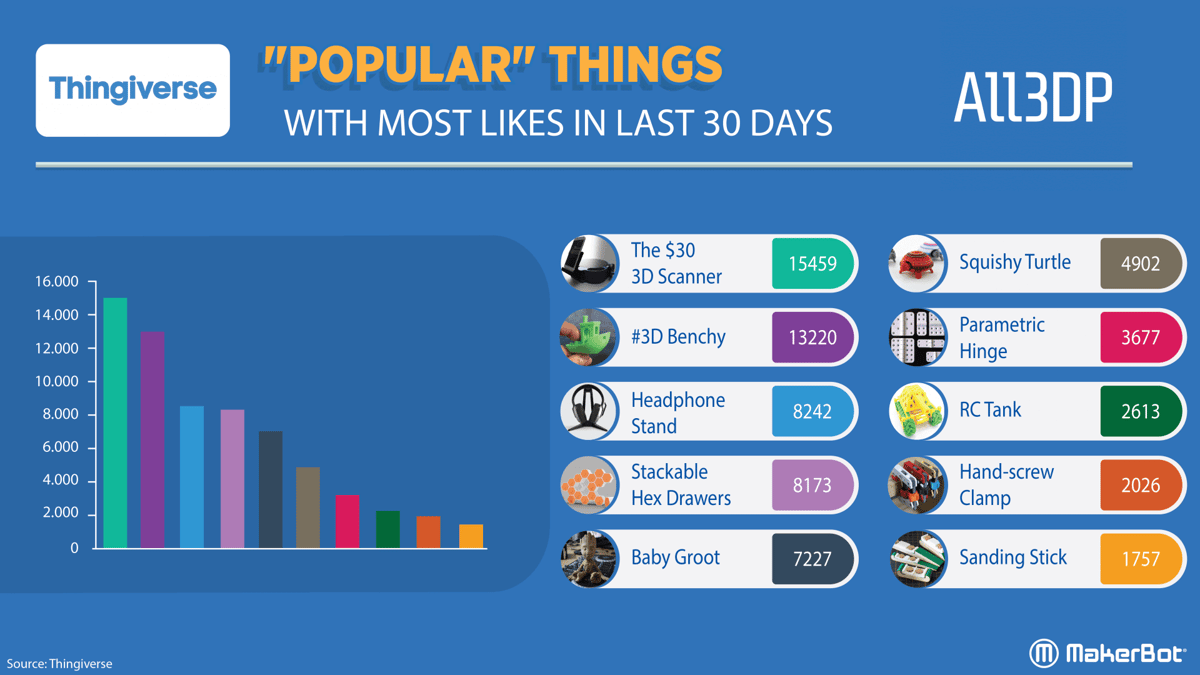
This chart shows the things with most “likes” on Thingiverse in the last 30 days.
Important to note is that these models are neither the most downloaded nor have had the most makes; that’s a separate scope of activity on the site. It’s simply a ranking of the models that have been given the most enthusiastic thumbs-up by visitors.
As such, it’s a nice blend of the things that makes the site so useful. Pop culture gets a nod with a strong showing from the Baby Groot sculpture (7227 likes), probably off the back of “Guardians of the Galaxy Vol. 2” from earlier in the summer.
Items of a more practical nature are present and correct, ranging from the Hand-Screw Clamp (2026 likes), the Parametric Hinge (3677 likes) and the Sanding Stick (1757 likes). Just the ticket for getting stuff done around the house.
MakerBot’s Tony explains:
“Although the Things with the most recent likes are really influenced by Things we’ve featured, this shows the great range of popular content. From the practical to the artistic, Thingiverse is an amazing place with so much creativity. Perhaps a better way to judge popularity is to also take into account data showing how people interact with Things like Remixes and Makes, which is when people build upon other people’s work and share pictures of their prints.”
Interior design projects come in the shape of the Stackable Hex Drawers (8173 likes) and the Headphone Stand (8242 likes), the latter of which is an in-house design from parent company MakerBot.
There are toys here, too. But the Squishy Turtle (4902 likes) and RC Tank (2613 likes) aren’t throwaway trinkets; they’re slightly more complex projects that require printing of separate components and some assembly.
But the top two spots are the most special; first up is a home 3D scanning studio (15459 likes) which requires $30 of components, followed by the legendary 3DBenchy (13220 likes) for calibration of your desktop machine.
The former is a useful item that should allow you to 3D print the objects you scan, creating a virtuous cycle. The latter is an easy way to check that your printer is continually at optimal performance and settings.
User Demographics
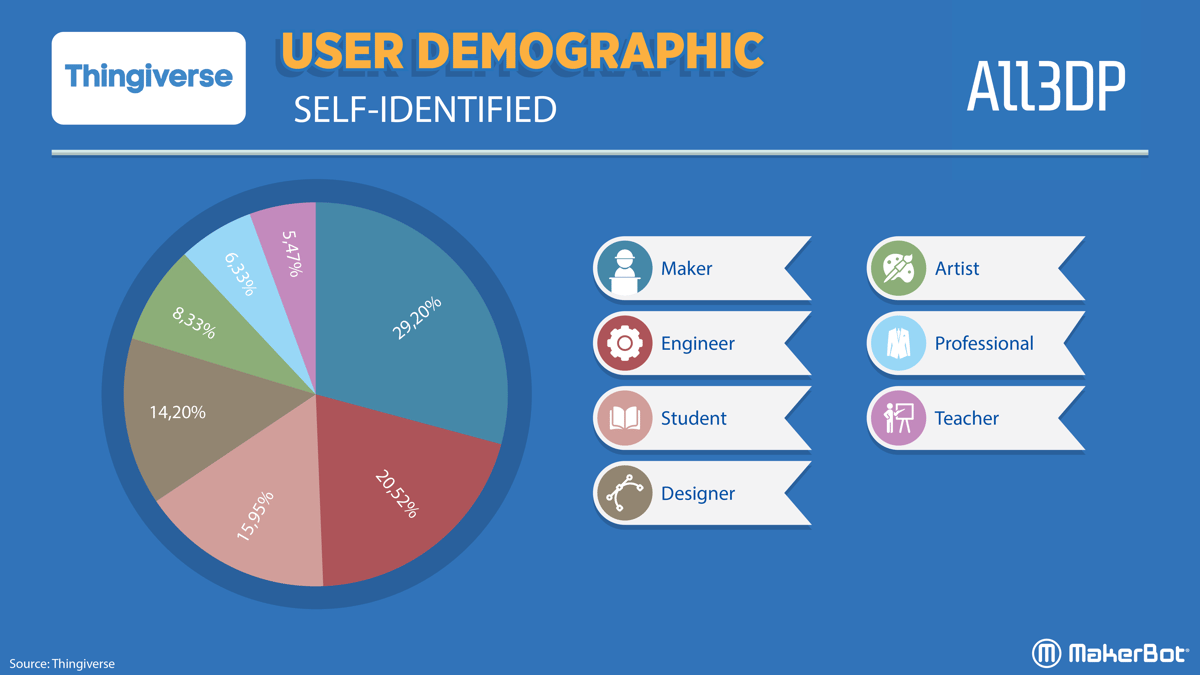
This chart provides a fascinating insight into the current user demographic on Thingiverse, where registered users have self-identified as a particular category on their profiles.
The surprising thing that leaps out from the chart is that teachers make up the smallest demographic group, with just 5.47% of the overall chart. That’s relevant because many desktop 3D printer manufacturers have identified education as an important market and pivoted accordingly. Is it possible that the market has been overestimated?
By way of a counterbalance, Students make up the third biggest demographic of the chart, with 15.95%. This could indicate that students have a significantly greater appetite for 3D printing, and perhaps there aren’t enough qualified individuals to teach them. Education leaders need to play catch-up?
But then again, the lion’s share of the demographics are given over to Makers and Engineers, occupying 50% of the chart between them. And since these labels are self-identified, there’s some flexibility in how they’re applied. Perhaps the case is that a teacher or a student would strongly prefer to identify first and foremost as a maker or an engineer.
“This is an interesting data set,” Tony says. “We know a lot of our users are Teachers, however in the beginning when creating a new account you could only identify as one type of user, so they may have chosen Maker instead of Teacher. Since we’ve added the ability to set multiple types, we need to get more people to update their profiles.”
Top 20 Countries
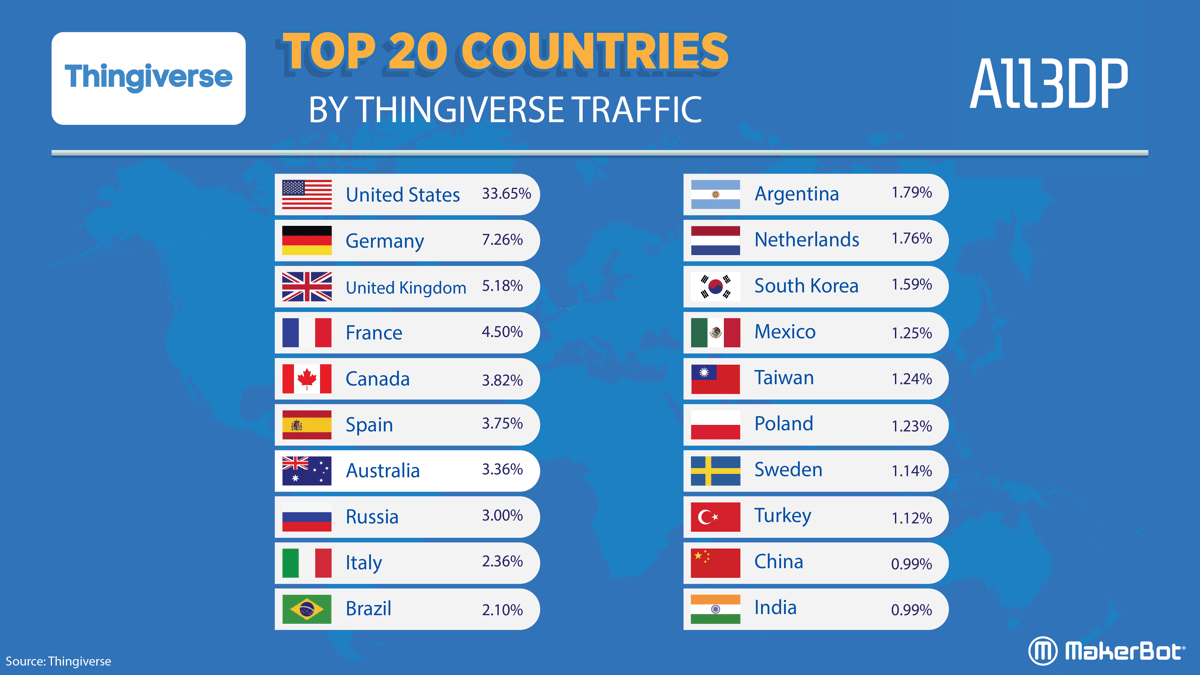
This is a breakdown of the top 20 countries visiting Thingiverse in the past 30 days.
It’s not surprising that the United States makes up the lion’s share, with one third of traffic in total. This reflects the fact that Thingiverse has strong roots in the US maker scene, and that many users of Thingiverse came to the site via the MakerBot line of desktop 3D printers.
Rounding out the top five in smaller numbers are Germany, the United Kingdon, France and Canada. And looking towards the bottom of the chart, we find precious few visitors from India, China and Turkey.
Tony adds:
“As someone who’s been with Thingiverse from almost the very beginning, it’s inspiring to see both Thingiverse and 3D printing spread around the world. It’s also very interesting to note that although we only support English, it appears nearly half of our visitors are not from English speaking countries.”
Another insight from this chart would be that those countries who are especially active in the production of desktop 3D printers — China, Poland, the Netherlands — are not especially well represented as Thingiverse users. Those nations perhaps have alternative sources for 3D models. Or the bulk of their customers reside overseas.
Thing Origin by Software
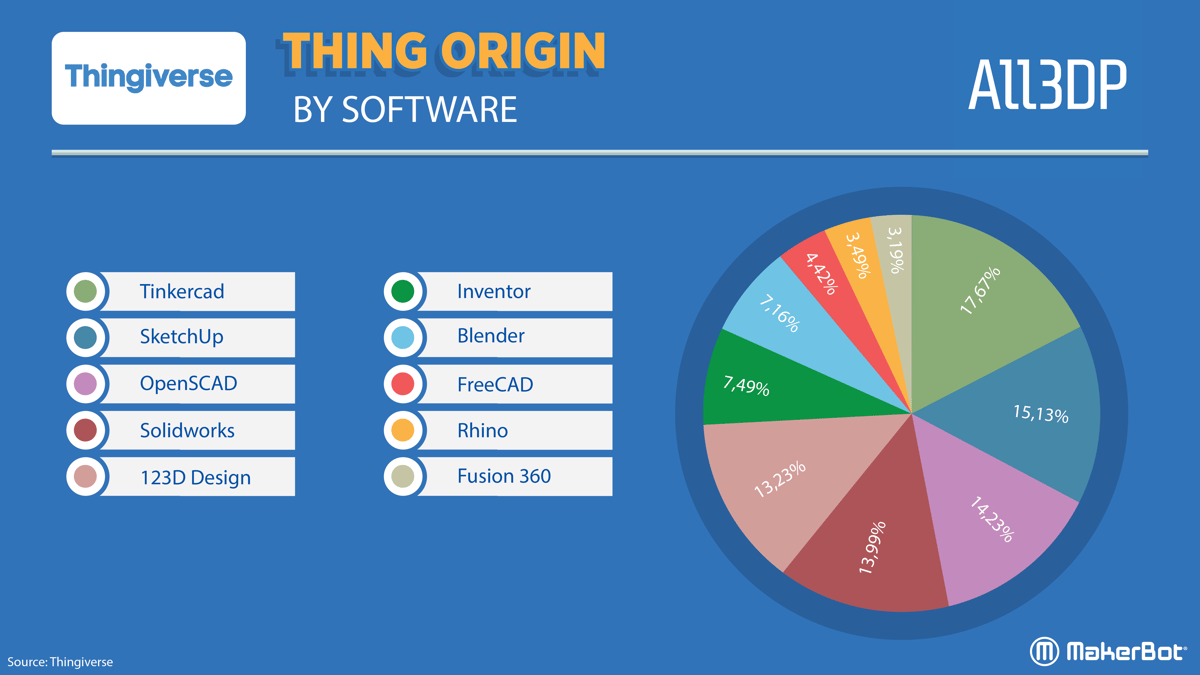
Finally we have the breakdown of Thing Origin; the software used to design the objects for 3D printing.
This chart is interesting because it seems to present a split between various software packages, with no clear leader. And that’s despite the vast differences in complexity and cost from software package to software package.
But looking a little closer, you will see that one software company emerges as the leader of the pack. Autodesk owns 4 of the 10 software packages on this list — Tinkercad, 123D Design (discontinued), Inventor, and Fusion 360 — which gives them a cumulative share of 41.58%.
Their various products present a “ladder” from easy to difficult 3D modeling software, and it’s pretty canny. That doesn’t mean they have a total monopoly, however.
Open source or free programs like Blender (7.16%), OpenSCAD (14.23%) and FreeCAD (4.42%) are also present and correct. And then you have business CAD applications like Rhino (3.49%) and Solidworks (13.99%) which are industry stalwarts.
By way of comparison, presented below is a chart of popular applications based on self-identification from Thingiverse users. Some discrepancies arise between the actual use for an application versus stated use, for example with Tinkercad and Blender.
Moreover, there are several applications in the self-professed chart that make no showing at all in the primary chart, like Photoshop, Illustrator and Meshmixer. A curious development.
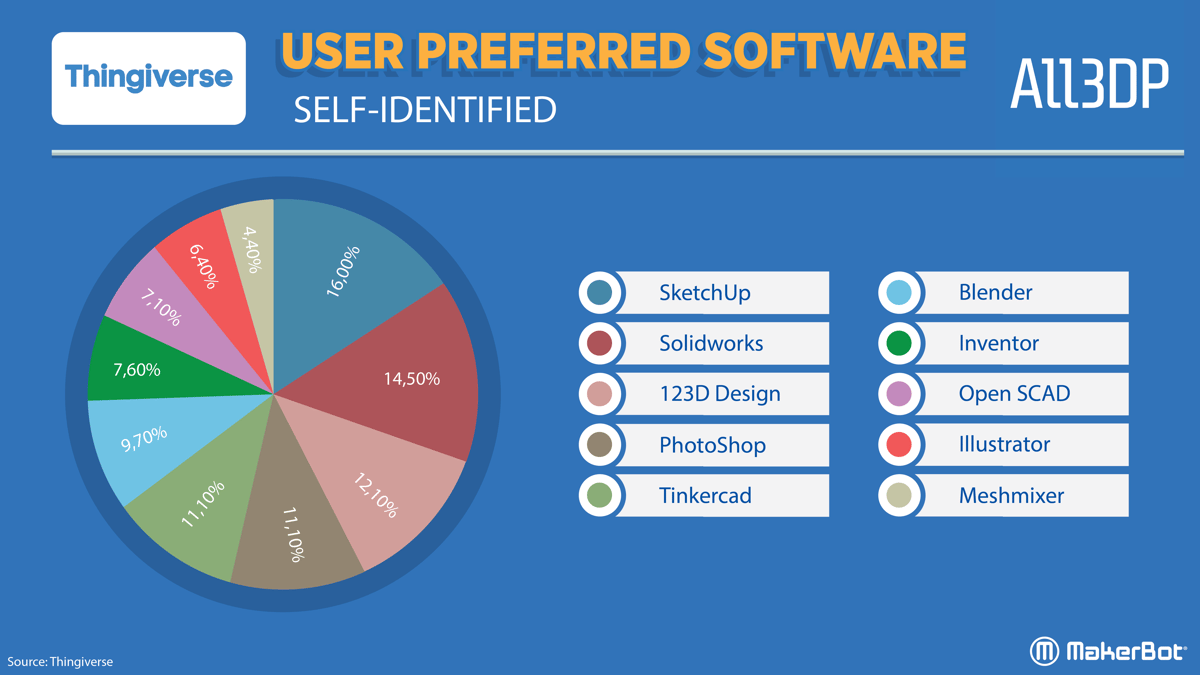
And that’s a wrap! What did you think? Did you learn something new about trends on Thingiverse in reading this article? Any surprises you didn’t expect to see? Any observations or conclusions you disagree with? Let us know in the comments below.
Hero Image by Jason Krieger
License: The text of "Most Popular Software and Models on Thingiverse Over 30 Days" by All3DP is licensed under a Creative Commons Attribution 4.0 International License.